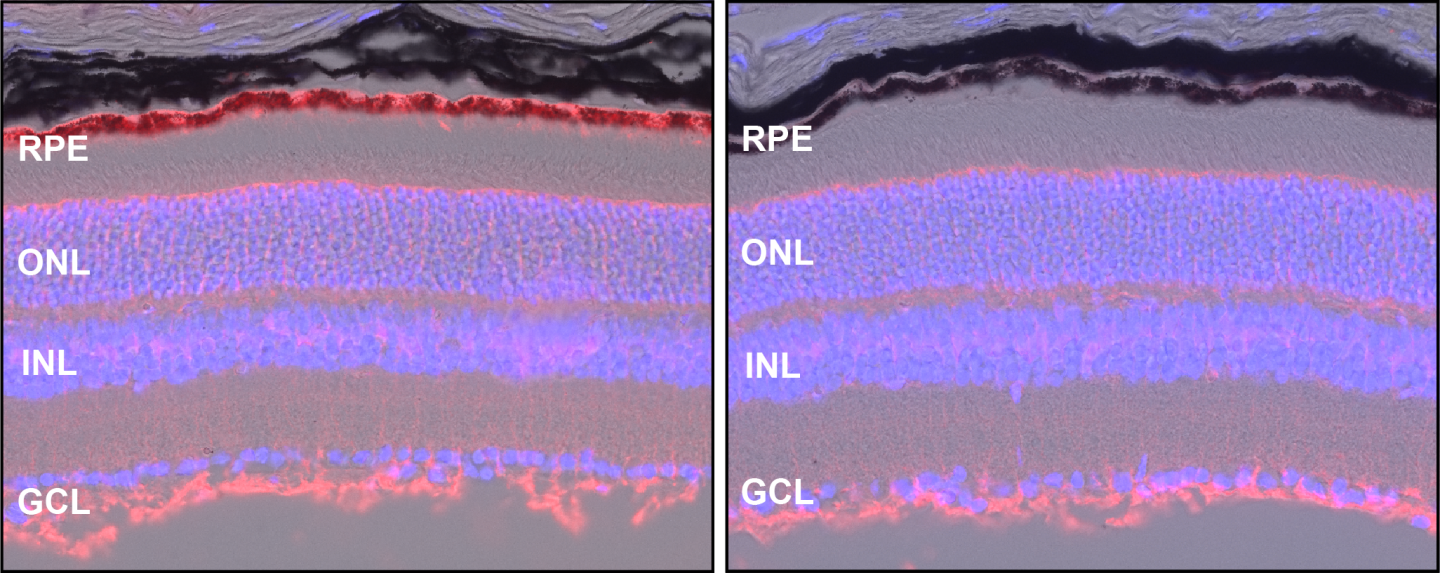UC Irvine study resolves the function of a key vision-supporting protein in cellular-level detail
Source: UCI School of Medicine

Fluorescence microscopy of mouse retinal cryosections showing CRALBP immunostaining (red fluorescence) in control (left) and RPE-CRALBP KO (right) mice. Cellular nuclei within the neural retina are marked by the blue fluorescence signal (DAPI).
Irvine, Calif., April 26, 2024 – Researchers at the University of California, Irvine have discovered a pivotal role for cellular retinaldehyde protein (CRALBP) in the retinal pigmented epithelium (RPE) in supporting the physiology of the light-sensing cells in our eyes, known as photoreceptors. The finding clarifies and highlights the importance of RPE cell targeting for CRALBP gene therapies.
“This study resolves a key question regarding the relative importance of the two cellular pools of CRALBP – one in the RPE and one in Müller cells – in supporting the function of the light-sensitive cells of the retina,” said the corresponding author Philip Kiser, PharmD, PhD, UCI associate professor of physiology & biophysics as well as ophthalmology. “Our data will assist in decision-making related to which retinal cells should be prioritized for receipt of gene replacement or genome-editing treatment for CRALBP-associated retinal diseases.”
In the retina, CRALBP is found in two distinct cell types that occupy different regions: the RPE and the Müller glia. The relative physiological contribution of these two CRALBP pools in supporting photoreceptors physiology has been debated due to inconsistent data from studies in different animal models.
For the study, which was recently published online in the journal Cell Reports, the team used conditional knockout mouse technology to ablate CRALBP from the retina, either in RPE or Müller glial cells. Removing CRALBP from the RPE produced a set of eye phenotypes closely matching those of mice with CRALBP deleted in all cells of the body.
“We found that loss of CRALBP in the RPE significantly reduces the rate at which the photoreceptors can operate,” said lead author Marco Bassetto, PhD, a postdoctoral researcher in Kiser’s laboratory at the UCI Center for Translational Vision Research. “Besides characterizing the retinal physiology of CRALBP, our work also suggests new therapeutic opportunities in the treatment and prevention of retinal damage induced by light.”
Other team members included Maximilian Halabi, a fourth-year UCI MD student and Dominik Lewandowski and Jianying Kiser, two project scientists in the Kiser lab. This work was accomplished in close collaboration with Alexander Kolesnikov, PhD, from the laboratory of Vladimir Kefalov, PhD, as well as Krzysztof Palczewski, PhD.
The work was performed within the UCI Center for Translational Vision Research and was supported by the U.S. Department of Veterans Affairs, Research to Prevent Blindness, the National Institutes of Health, the Knights Templar Eye Foundation, and the International Retina Research Foundation.


